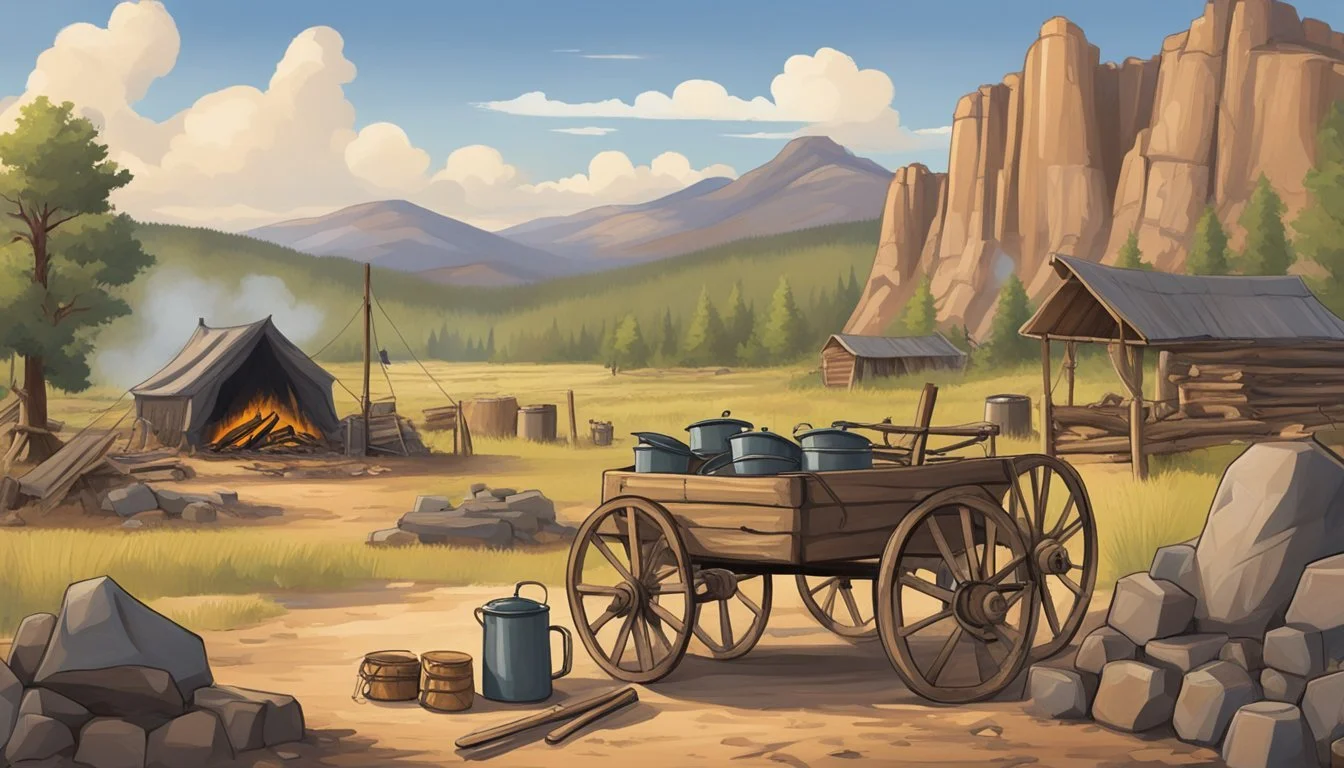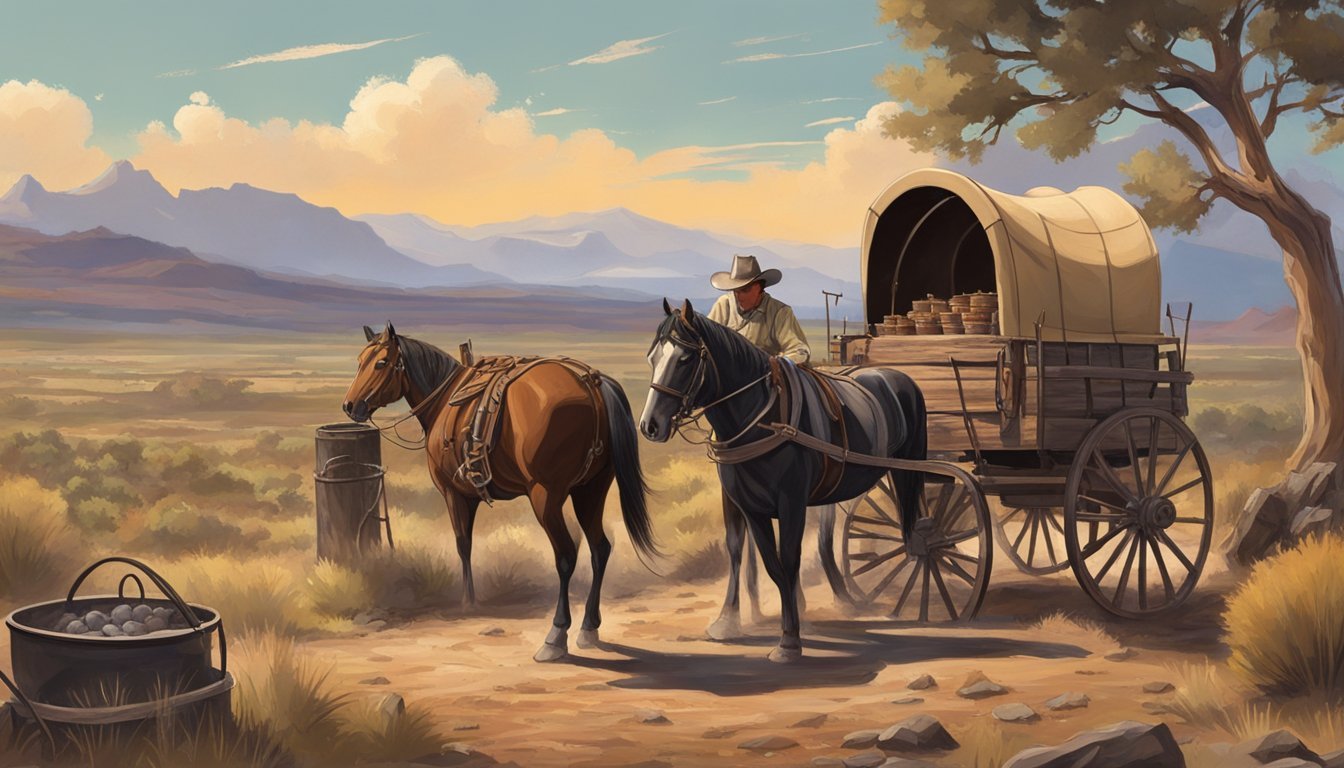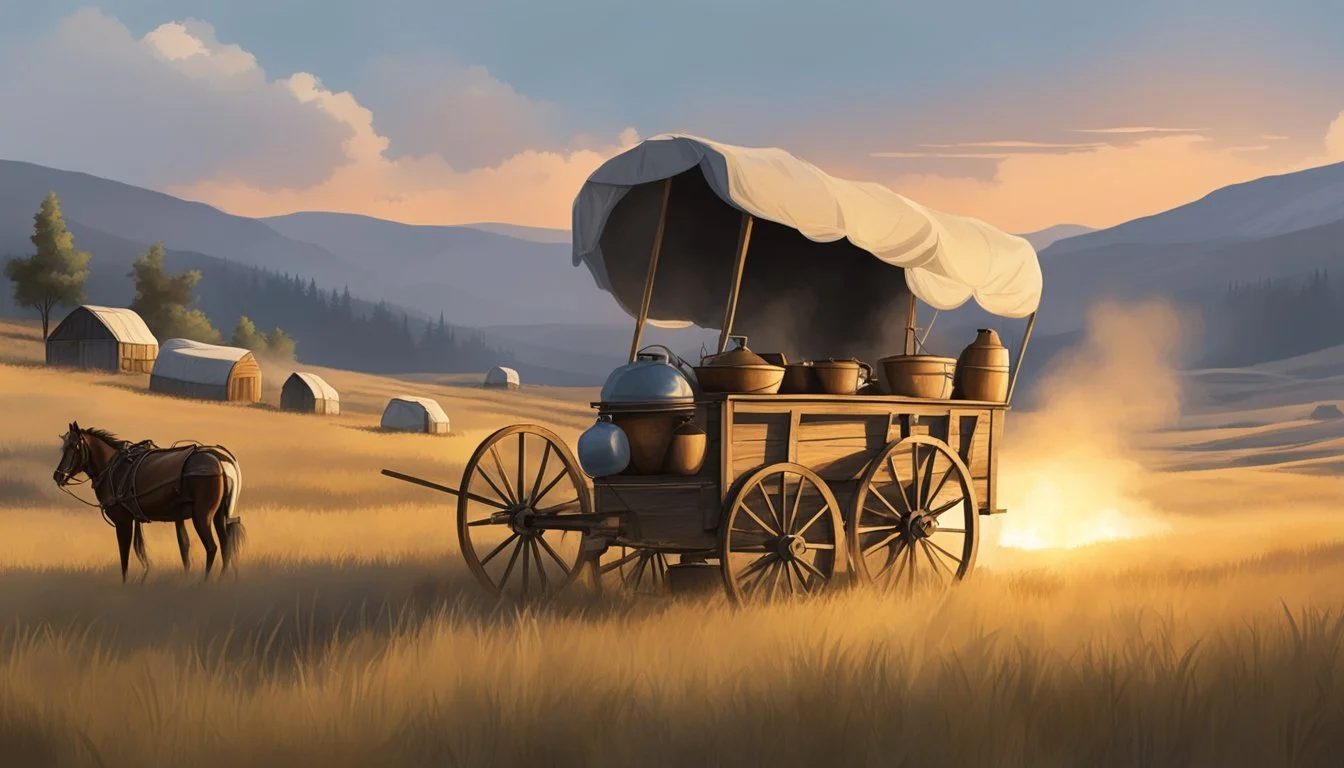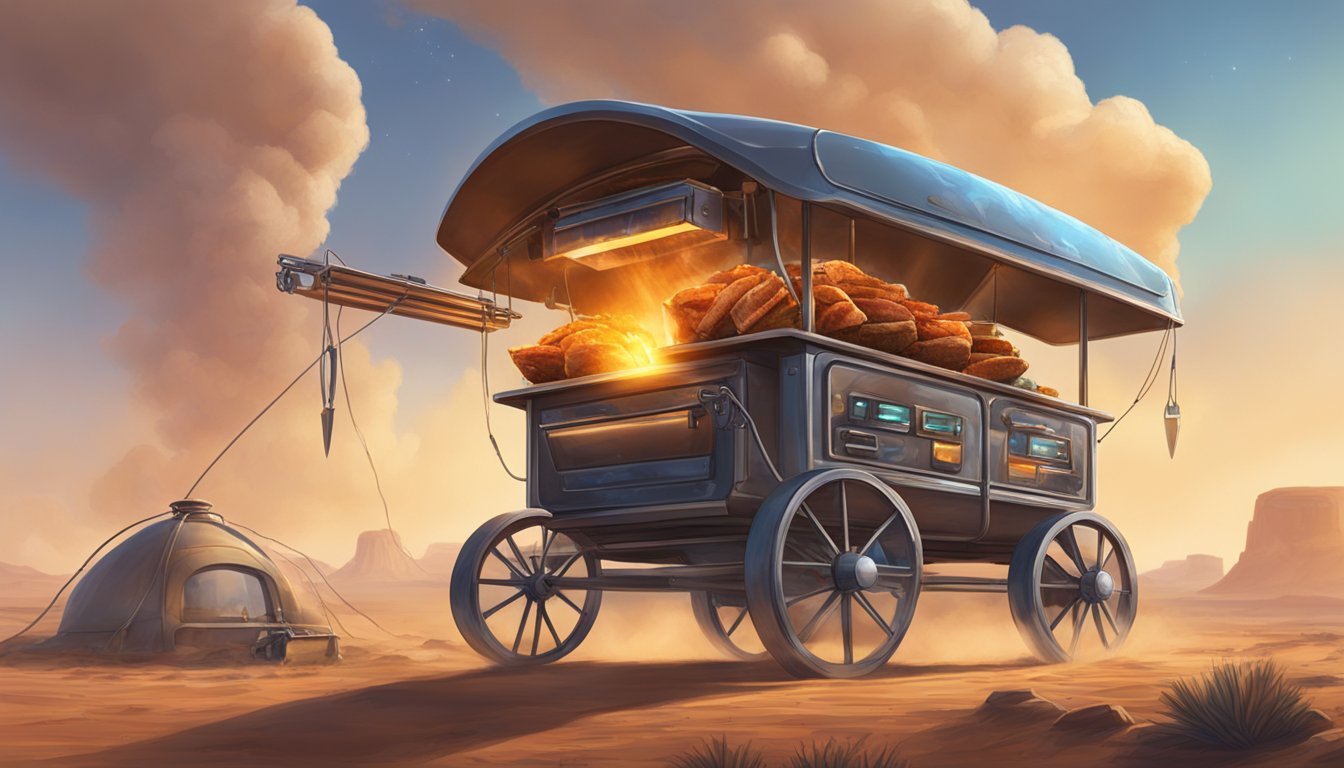Cowboy Cuisine
Exploring the Roots of Chuckwagon Cooking
In the American West, the chuckwagon is a symbol of culinary resilience and tradition, a rolling kitchen that sustained cowboys during long cattle drives. Chuckwagon cooking is the cornerstone of what is known as cowboy cuisine, a type of food that's deeply intertwined with Western heritage. Originated by Texas rancher Charles Goodnight in 1866, these mobile food units allowed cowhands to stay nourished while traversing vast distances to move cattle from one place to another.
Cowboy cuisine blends a variety of culinary influences reflecting the diversity of people who shaped the American frontier. The recipes and methods used in chuckwagon cooking draw from Mexican, Native American, and European roots, creating a distinct and hearty fusion. Key ingredients, like beef, beans, corn, chili peppers, and a range of spices, were combined in innovative ways to make satisfying meals that could be cooked over an open fire or in a Dutch oven.
The practicality of chuckwagon meals lay in their simplicity and nutrition, catering to the needs of cowboys who required sustenance for the rigorous demands of their work. Dishes were designed for convenience, utilizing simple, non-perishable ingredients that could withstand the rugged conditions of the trail. As chuckwagon cooks whipped up beans, biscuits, and coffee, they did more than just feed - they fortified the cowboy spirit with meals that were as much a part of the Western identity as the cattle drives themselves.
Historical Context of Chuckwagon Cooking
Chuckwagon cooking plays a pivotal role in the story of the Old West, emerging as a practical solution to the culinary challenges faced by cowboys during long cattle drives.
Origins of the Chuckwagon
The concept of the chuckwagon was a byproduct of the extensive cattle drives that followed the Civil War. With the expansion of the railroads, there was demand to move cattle to markets that would now reach further than ever before. These journeys required mobile food support for the cowboys who would be herding cattle across the expansive open landscapes. The Old West saw the rise of the chuckwagon as an innovative response to this need.
Charles Goodnight and the Cowboy Trail
Charles Goodnight, a Texas rancher and former Civil War scout, is credited with inventing the chuckwagon in 1866. Goodnight's idea to repurpose a sturdy Studebaker wagon, a durable military surplus vehicle, into a mobile kitchen revolutionized outdoor cooking. The chuckwagon was equipped with drawers and shelves for storing utensils and the cowboy's personal belongings. A hinged lid opened to reveal a flat surface that would serve as the cook's work area, and underneath, a "boot" would carry the ever-important Dutch oven and other large cooking items. This fully mobile kitchen accompanied drovers as they moved herds up the Cowboy Trail, which further shaped the culture and operations of the American cattle drives typical of the Old West era.
The Chuckwagon: Design and Functionality
The chuckwagon was ingeniously designed with functionality in mind, serving as a mobile kitchen with the essential tools for provisioning cowboys on cattle drives.
The Chuck Box
The chuck box, typically found at the rear of the wagon, was the cornerstone of the chuckwagon's design. It stored various cookware and non-perishable ingredients. Feature-wise, the chuck box held:
Shelves and compartments: Organized storage for utensils, spices, and food.
Hinged lid: Doubled as a preparation table or served as a surface for meal service.
The kitchen tools within a chuckwagon's chuck box included, but were not limited to:
Cast iron skillets and pots: Essential for heat resilience and even cooking.
Coffee percolator: A staple for brewing cowboy coffee over an open flame.
Utility tools: Knives, serving spoons, and other utensils rounded out the cook's ensemble.
Adaptations and Innovations
Over time, the chuckwagon saw several adaptations enhancing its functionality. Key innovations addressed the practical realities of feeding crews in diverse and often challenging outdoor conditions.
Canvas covers: Protection against the elements for both supplies and prepared meals.
Foldable legs on tools: Designed for creating a stable cooktop surface.
The design allowed for the transport and accessibility of kitchen tools crucial for cook-offs, where chuckwagons now act both as historical exhibits and functional cooking stations. Chuckwagon cook-offs have become events where enthusiasts celebrate the traditions of cowboy cooking, putting the functionality and design of these rugged mobile kitchens to the test.
Cowboy Cuisine Staples
Cowboy cuisine is deeply rooted in practicality and nourishment, providing the energy needed for the rigorous tasks of cowboys. Key elements include staple foods that were easy to preserve, hearty, and simple to prepare over open fires.
Hearty Main Dishes
The core of chuckwagon food was beef, attributed to the cattle-driving lifestyle that necessitated the chuckwagon's existence. As majority of the diet for cowboys on the trail, beef was often prepared as stews or roasted over the fire. Beans were another quintessential component, frequently cooked in large pots to serve as a filling, protein-rich meal that could feed a crew efficiently.
Beef Stew: (What wine goes well with beef stew?) Slow-cooked with spices and whatever vegetables were available; it's hearty and satisfying.
Bean Dishes: Pinto beans were the usual choice, prepared in pots with a mix of spices.
Bread and Biscuits
Bread and biscuits held a special place on the menu, serving as versatile sides that could sop up gravy or stew juices. These staples were baked in cast iron Dutch ovens, producing a crisp exterior and soft, fluffy interior.
Sourdough Bread: Often made from starters that were kept and maintained throughout the trail drives.
Biscuits: Quick and easy to make, served fresh and could be adapted to include available ingredients like cornmeal.
Desserts and Sweets
Desserts were a rare treat, considering the limitations on preserving sweet ingredients. However, some staples like cobblers made from canned or dried fruits were possible and offered a sweet end to a meal.
Cowboy-style Cobblers: Fruit fillings baked under a simple biscuit or crust topping, utilizing cast iron cookware.
Cooking Techniques and Equipment
In the challenging conditions of the open trail, chuckwagon cooks utilized resourceful techniques and durable equipment to prepare meals. This section delves into the specific cookware, campfire management, and tools fundamental to chuckwagon cuisine.
Dutch Ovens and Cast-Iron Cookware
Dutch ovens were a cornerstone of chuckwagon cooking, thanks to their versatility and resilience. Cast-iron skillets also featured prominently, capable of withstanding high heat necessary for searing meats and simmering stews. Both were placed directly onto coals or hung over the campfire using a tripod. The dutch oven, in particular, enabled cooks to bake bread and cobblers, making it an indispensable asset on the trail.
Uses: Baking, stewing, frying
Maintenance: Seasoning of cast iron to prevent rusting and stickiness
Placement: Directly on hot coals or suspended over a campfire
Campfire Management
Effective campfire management was crucial to regulate cooking temperatures and timings. Cooks used different arrangements of coals to create hot zones for boiling and searing, and cooler areas for slow cooking and simmering. Mastery over the campfire also meant maintaining a steady supply of embers throughout the cooking process, ensuring that meals could be prepared at any time of day.
Fire building: Teepee or log cabin styles for different heat levels
Coal distribution: Strategic placement for temperature control
Safety: Keeping flames contained and manageable
Utensils and Tools
A variety of utensils and tools were required for the diverse tasks involved in preparing a meal. These included long-handled spoons and forks for safety near the fire, sharp knives for butchering meat, and leather gloves for handling hot cookware. Organization was key, as the cook needed to have these tools readily accessible to work efficiently.
Knives: Butchering and general-purpose cutting
Spoons/Forks: Stirring, serving, and flipping
Safety: Leather gloves and long handles to protect from burns
Role of Food in Cowboy Life
Food was not merely a means to satisfy hunger for cowboys; it was a crucial element that sustained their energy and spirits during exhausting work on cattle drives and at the ranch.
On the Cattle Trail
During cattle drives, cowboys worked long hours herding cattle across the open range. Their meals needed to be nutrient-dense and easy to prepare under the conditions of the trail. Charles Goodnight's invention, the chuckwagon, was a game-changer in how food was stored, prepared, and served during these drives. Cowboys often consumed stews, beans, and coffee which provided the necessary calories and warmth after a long day's work.
Typical Menu on the Trail:
Breakfast: Hot coffee and sourdough biscuits
Lunch: Beef stew with potatoes and onions
Dinner: Beans, salted pork, and occasionally, a dessert like Dutch oven peach cobbler
At the Ranch
Back at the ranch, the food scene was less transient but equally important. Ranchers ensured that cowboys had hearty meals to start and end their day. These meals were more varied than those on the trail and included vegetables from the garden and fresh beef from the herd. Cowboys often participated in communal meals that fostered camaraderie and reinforced the hierarchy within the ranch's workforce.
Common Ranch Meals:
Breakfast: Eggs, bacon, and hotcakes
Dinner: Roasts or steaks with sides of potatoes or cornbread
In both settings, the shared meals were not just a respite but also a ceremony that encapsulated the cowboy life, symbolizing a well-deserved reward for their hard work.
Recipes and Adaptations
In the era of chuckwagon cooking, cowboys relied on hearty meals that provided the necessary sustenance for their demanding work. These dishes were built on simplicity and the ability to be cooked over a campfire or in a single pot.
Authentic Recipes
Cowboy Beans: A staple of the chuckwagon menu, cowboy beans were a high-protein dish that could be simmered over a low flame. The recipe typically included pinto beans, bacon or salt pork, and a blend of onions and garlic, with chili as an optional but common spice.
Ingredients:
1 lb dry pinto beans
1/2 lb bacon or salt pork, diced
1 onion, chopped
2 cloves garlic, minced
Salt and chili powder to taste
Preparation: Beans were soaked overnight, then slow-cooked with the meat and seasonings until tender.
Sourdough Biscuits: These biscuits used a starter made from flour and water that captured wild yeasts and lactic acid bacteria from the environment. In the absence of commercial yeast, the starter provided the leavening necessary for these staples.
Ingredients for Starter:
1 cup flour
1 cup warm water
1 tsp sugar (optional)
Preparation: Once the starter was established, it was combined with more flour, baking powder, and salt to make a dough. After a resting period, the dough was then shaped into biscuits and baked.
Contemporary Variations
Contemporary chefs and home cooks often pay homage to these traditional recipes with modern twists, ensuring that meals can be conveniently prepared with present-day kitchen equipment and broader ingredient availability.
Updated Cowboy Beans:
Ingredients may include: Ground beef or turkey, canned beans, bell peppers, and barbeque sauce.
Cookware: While historically cooked in a cast iron pot, modern versions might utilize slow cookers or pressure cookers.
Modern Sourdough Biscuits: While the essence of sourdough remains, home cooks may adapt recipes for modern ovens, possibly adding butter for richness, and using baking soda as an additional leavening agent to create lighter, fluffier biscuits.
Dutch oven cooking remains a tribute to chuckwagon traditions and is embraced by campers and outdoor enthusiasts who seek to replicate the authenticity of open-fire cooking. Regardless of the tools used, the spirit of the chuckwagon lives on in kitchens where these recipes and adaptations continue to nourish and delight.
Cultural Significance and Legacy
Chuckwagon cooking is more than a historical footnote; it is a rich legacy that continues to influence culinary traditions and events across America.
Chuckwagon Events and Cook-Offs
Chuckwagon events and cook-offs serve as modern-day celebrations of cowboy heritage. They reenact the preparation of comfort food in a historical context, preserving the methods and spirit of the old chuckwagon cookouts. These gatherings often turn into competitions where participants vie for the title of the best authentic Western meal. Indeed, some events have become annual traditions, drawing people passionate about maintaining and experiencing this unique aspect of American culture.
Influence on Modern American Cuisine
The essence of chuckwagon cuisine, emphasizing hearty ingredients and simplicity, has undeniably trickled down to modern American comfort food. Techniques such as slow cooking meats and stews embody the practical yet flavorful approach of the chuckwagon cook. Dishes like Dutch Oven Peach Cobbler, which combine simple ingredients and straightforward preparation, capture the culinary spirit that fed cowboys on long cattle drives. This influence extends beyond recipes to inspire the communal aspect and rustic aesthetic prevalent in many contemporary American eateries.
Preservation of Cowboy Cooking Traditions
The commitment to preserving the unique heritage of cowboy cooking is evident through various dedicated efforts. These initiatives ensure that an integral part of Western history continues to enrich current and future generations.
Historical Reenactments
Historical reenactments play a crucial role in preserving the authenticity of cowboy cooking traditions. By reconstructing the activities surrounding the chuckwagon, including the preparation of dishes with original ingredients and methods, these reenactments offer a tangible experience of the past. Participants often dress in period attire and use tools and equipment from the era, which helps to provide an immersive learning environment. This meticulous attention to detail contributes significantly to the transmission of traditional cowboy cooking techniques and values.
Educational Programs
Educational programs aim to instill an appreciation for cowboy cooking and Western heritage among diverse audiences. Various institutions, including museums, historical societies, and culinary institutes, offer:
Workshops on traditional cowboy cooking methods
Seminars about the historical significance of the chuckwagon
Culinary classes that feature recipes from the trail
Through these structured educational efforts, important aspects of cowboy cooking and Western life are meticulously documented and shared. Such programs often combine practical hands-on instruction with academic learning to ensure a comprehensive understanding of this culinary tradition.
The Future of Cowboy Cuisine
As cowboy cuisine continues to evolve, it maintains a strong connection to its roots while embracing new twists and media representation.
Innovation Within Tradition
Innovation in cowboy cuisine doesn't mean abandoning the hearty, rustic dishes that cowboys enjoyed on the trail. Instead, chefs and food enthusiasts are focusing on refining traditional plates by incorporating fresh, locally-sourced ingredients and modern culinary techniques. Cookbooks are emerging that offer contemporary takes on classics, such as using sous-vide methods to tenderize tough cuts of beef typically found in cowboy meals. The tradition of open fire cooking is also seeing a resurgence, with modern equipment making it more accessible for outdoor enthusiasts to explore authentic flavors.
Cowboy Cuisine in Popular Media
Cowboy cuisine has galloped from campfires to the forefront of popular media. Reality cooking shows and food competitions frequently showcase cowboy-inspired challenges, often with a focus on the authenticity and skills needed to prepare these robust meals. Additionally, television series and food-focused documentaries have started to highlight the cultural history and present innovation within cowboy culinary culture, capturing audiences' appetites for both the food and the storied traditions behind it.
Conclusion
Chuckwagon cooking transcends mere sustenance, embodying a rich tapestry woven from diverse cultural threads. As it approaches the future, it both honors its storied heritage and adapts to contemporary tastes.
Heritage: This cuisine is a testament to the resilience and ingenuity of cowboys who navigated the harsh conditions of cattle drives. Drawing upon Mexican, Native American, and European traditions, it is a culinary mosaic reflective of the American spirit.
Cultural Significance: Chuckwagon cooking today stands not just as a historical footnote, but as a living cultural artifact. Its practices and dishes celebrate the cowboy ethos, a symbol of the rugged individualism that is a hallmark of the American narrative.
Future: With each passing year, enthusiasts and chefs are revisiting and revitalizing chuckwagon recipes, ensuring that the flavors – as well as the stories – continue to resonate with new generations.
This cuisine’s journey from campfire to contemporary kitchens continues to influence the culinary landscape, assuring that the essence of chuckwagon cooking will remain a cherished part of America's gastronomic identity.









